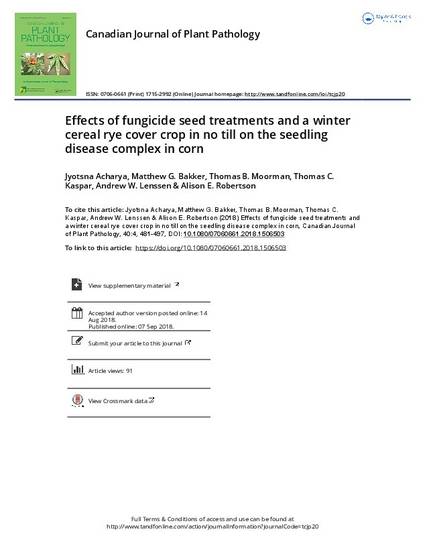
Corn seed is treated with various fungicide active ingredients that target several fungal and oomycete genera in the corn seedling disease complex. In this study, we investigated the effects of various combinations of fungicides as seed treatments on disease development, pathogen prevalence and seedling growth of corn planted after a winter cereal rye cover crop or a winter fallow. Under controlled environment conditions, corn seed was treated with a combination of metalaxyl, pyraclostrobin, fludioxonil, ipconazole and sedaxane to reduce infection by Pythium, Fusarium and Rhizoctonia solani (treatment ALL); metalaxyl alone to reduce Pythium (P); metalaxyl and pyraclostrobin to reduce Fusarium and Pythium (FP); pyraclostrobin, fludioxonil, ipconazole and sedaxane to reduce Fusarium and R. solani (FR); and non-treated seed control (NT). Complementary field trials compared the ALL seed treatment against NT, with and without winter cereal rye. Under cold, wet environmental conditions, winter cereal rye negatively affected corn seedling growth and increased seedling root disease and Pythium incidence. In general, seed treatments improved seed germination and seedling growth (P < 0.05) in controlled environment conditions. Seed treatments active against Pythium spp. (i.e. P, FP and ALL) reduced radicle disease index scores (P < 0.01) compared with FR and NT. Pythium spp. were recovered less frequently from corn seedlings planted after winter cereal rye when treated with P, FP and ALL compared with FR and NT. No seed treatment effect was detected on the recovery of Fusarium spp. In the field, no effect of a fungicide seed treatment was detected on corn seedling growth or root disease incidence following winter cereal rye. Mesocotyl disease incidence, however, was reduced when using a fungicide treatment in 2014. These data suggest that Pythium species play a major role in the corn seedling disease complex following a winter cereal rye cover crop. Consequently, disease management in corn systems that include a winter cereal rye cover crop should explicitly consider Pythium spp.
Available at: http://works.bepress.com/alison-robertson/271/

This article is published as Acharya, Jyotsna, Matthew G. Bakker, Thomas B. Moorman, Thomas C. Kaspar, Andrew W. Lenssen, and Alison E. Robertson. "Effects of fungicide seed treatments and a winter cereal rye cover crop in no till on the seedling disease complex in corn." Canadian Journal of Plant Pathology 40, no. 4 (2018): 481-497. doi: 10.1080/07060661.2018.1506503.